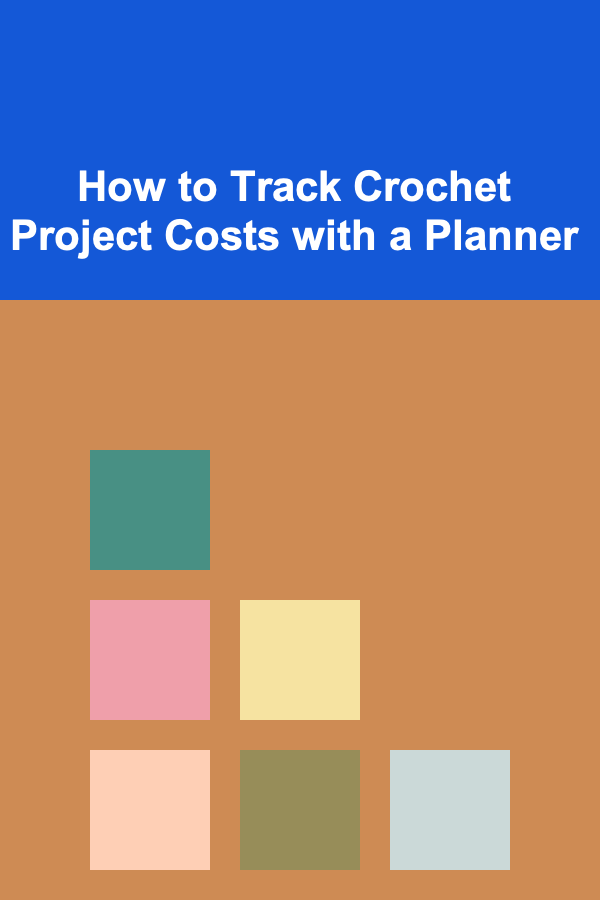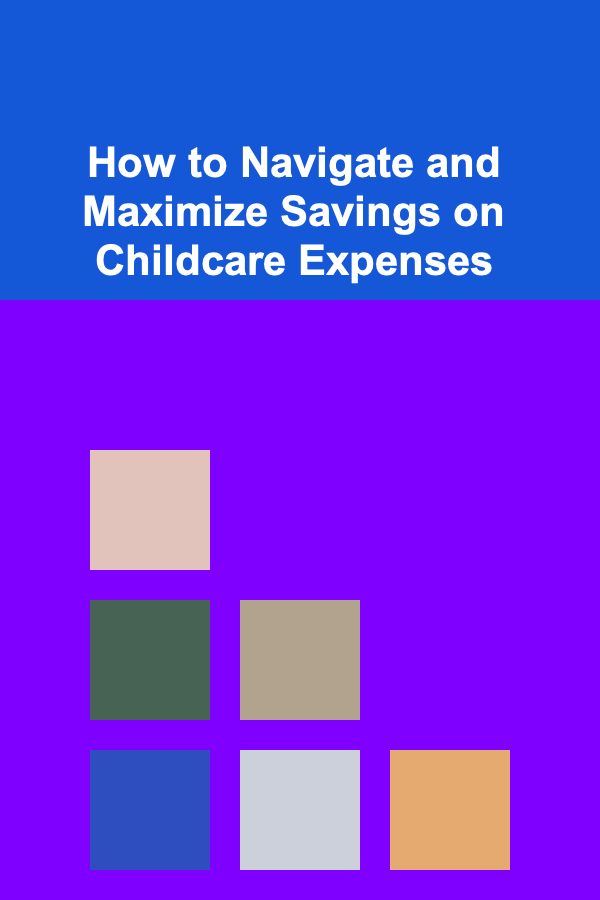
How to Track Crochet Project Costs with a Planner
ebook include PDF & Audio bundle (Micro Guide)
$12.99$6.99
Limited Time Offer! Order within the next:

Crochet is an incredibly fulfilling craft, but it can also become expensive. From yarn to hooks, patterns, and accessories, the costs can quickly add up, especially for larger projects. As a crochet enthusiast, you may find yourself wondering how to keep track of all the materials, tools, and other expenses related to your crochet projects. This is where a planner comes in.
Tracking crochet project costs is not just about budgeting---it's also a way to keep a clear record of your work, help you plan for future projects, and ensure you don't overspend. By maintaining a planner, you can create a comprehensive overview of your crochet finances and use it as a resource for future crafting endeavors.
In this article, we will explore in-depth how to track crochet project costs with a planner, including why it's essential, how to organize your costs effectively, and tips for making the most of your planner.
Why Track Crochet Project Costs?
Tracking your crochet project costs offers several advantages, whether you're a hobbyist or a professional crafter:
1. Better Budget Management
The most obvious reason to track crochet project costs is to manage your budget. Crochet can become expensive over time, especially when you invest in high-quality yarn, premium patterns, or special accessories. By keeping track of each project's costs, you can prevent overspending and plan for future materials.
2. Project Evaluation
Tracking costs allows you to evaluate the financial aspect of each project. By knowing how much you spent on yarn, tools, and other materials, you can assess whether a project was worth the investment. This helps you make informed decisions about which types of projects are more cost-effective or what types of yarn and tools provide the best value.
3. Future Planning
Once you've tracked several projects, you'll have a comprehensive record of the materials you prefer, their costs, and the patterns you use. This data can be incredibly useful when planning future crochet endeavors. For example, if you see that a certain type of yarn consistently fits within your budget, you may opt to use it again in future projects.
4. Learning and Growth
Tracking your costs is not just about numbers; it's also about learning and growing as a crafter. By reflecting on how much you've spent, you can identify areas where you might be overspending or wasting materials. This enables you to improve your skills, find more cost-effective ways to craft, and get better at managing your resources.
Types of Costs to Track
To effectively track your crochet project costs, you need to understand the various expenses involved in each project. Here are some of the primary categories to consider when tracking costs:
1. Yarn
Yarn is usually the most significant expense in any crochet project, so it's essential to keep track of its cost. There are several factors to consider:
- Yarn Type and Material: Different types of yarn (wool, cotton, acrylic, etc.) come at different price points. Specialty yarns like hand-dyed or luxury fibers (silk, alpaca, etc.) tend to be more expensive.
- Yarn Weight: The amount of yarn you need depends on the weight of the yarn and the size of your project. Tracking how many skeins of yarn you use and their individual prices is key.
- Yarn Quantity: Keep track of how much yarn you buy and how much you actually use. Sometimes, you may end up with leftover yarn that you can use for future projects.
2. Hooks and Tools
While crochet hooks are often a one-time investment, many crafters like to have different sizes or types (ergonomic, bamboo, metal, etc.). The cost of hooks and other tools (scissors, stitch markers, tape measure, etc.) can add up over time, especially if you frequently upgrade or replace tools.
3. Patterns
Some crochet patterns are free, while others are paid. It's important to track how much you spend on paid patterns, especially if you're making a series of similar projects. Patterns can be purchased in a variety of formats (books, magazines, downloadable PDFs, or subscription services), so keep track of the costs associated with each one.
4. Notions and Accessories
Other tools and accessories such as buttons, beads, sewing needles, and project bags are often necessary to complete a project. These smaller items may seem insignificant, but their costs can add up over time, so tracking them ensures that no cost goes unnoticed.
5. Shipping and Handling
When purchasing yarn, tools, or patterns online, don't forget to include shipping costs. These can significantly add to your total expenses. Make sure to track the cost of delivery separately for each project, especially if you're ordering multiple items for different projects at once.
6. Time Investment (Optional)
While time isn't typically associated with monetary costs, many crocheters like to track the hours they spend on each project. This is especially useful if you're thinking of selling your crochet items, as it helps you understand how much you're "earning" per hour when you price your work.
Using a Planner to Track Crochet Project Costs
A planner is an excellent tool for tracking all the various costs of your crochet projects. Whether you prefer a traditional paper planner or a digital one, the goal is the same: to keep a detailed record of each project's expenses and timeline. Here's how you can make the most of your planner:
1. Choosing the Right Planner
There are several types of planners you can use for tracking your crochet projects:
- Physical Planners: Some crafters prefer physical planners for a more tactile experience. You can find planners specifically designed for crafters, or you can use a standard daily planner with a customized crochet section.
- Bullet Journals: A bullet journal is a flexible option that allows you to create custom spreads for tracking crochet costs. It's a great choice for those who want to add a creative touch to their tracking system.
- Digital Planners: Digital planners or spreadsheets (Google Sheets, Excel, etc.) offer convenience and flexibility. You can access your planner from multiple devices and easily make changes.
2. Setting Up Your Planner
Once you have your planner, it's time to set up your system for tracking crochet costs. Here are some essential sections you may want to include:
- Project Overview: Create a section for each crochet project with space to note the project's name, the intended recipient (if any), the pattern used, and the yarn type.
- Material Costs: Track each material (yarn, tools, patterns, etc.) you purchase for the project, along with the quantity, price per unit, and total cost.
- Completion Date: Record the date you finished the project. This helps you track how long it takes to complete a project and estimate time and cost for future endeavors.
- Extra Costs: Don't forget to account for any extra costs like shipping, notions, or accessories.
- Total Cost: Calculate the total cost of the project by adding up all the expenses you've tracked. This is an essential part of budgeting for future projects.
3. Using a Spreadsheet for Easy Tracking
For those who prefer a more automated and organized system, using a spreadsheet is an excellent option. Here's how to structure your crochet project tracking spreadsheet:
- Column 1: Project Name: Name each project (e.g., "Winter Scarf" or "Baby Blanket").
- Column 2: Yarn Used: Record the type of yarn, brand, and color.
- Column 3: Quantity and Cost: Track how many skeins you used and the price per skein.
- Column 4: Pattern: Note whether the pattern was free or paid and the cost of any paid patterns.
- Column 5: Tools and Accessories: List any tools or accessories purchased specifically for the project and their costs.
- Column 6: Shipping: Include the shipping costs if you purchased online.
- Column 7: Total Cost: Sum the costs for each project to give you a quick view of how much you spent.
You can also add additional columns to track the number of hours worked, project status (e.g., completed, in-progress), and any specific notes.
4. Reviewing Your Tracker Regularly
Make it a habit to update your planner regularly to avoid forgetting any small details. After each project, take the time to review the costs and evaluate how you can improve your spending for future projects. This reflection is valuable and will help you become more mindful of your crafting expenses.
5. Reflecting on Cost-Effectiveness
After tracking several projects, take time to reflect on your costs. Look for patterns, such as which types of yarn you tend to use most often and whether there are cheaper alternatives that might offer similar results. You can also assess the overall efficiency of your planning process.
Tips for Saving Money on Crochet Projects
While tracking costs is important, there are also ways to reduce expenses without sacrificing the quality of your work. Here are some tips to help you save money on your crochet projects:
- Buy Yarn in Bulk: Many yarn stores offer discounts when you buy in bulk. If you often use the same yarn type, this can be a cost-effective option.
- Use Leftover Yarn: Save leftover yarn from previous projects. You can use it for small projects or create scrap projects, such as blankets or shawls.
- Choose Affordable Patterns: While many patterns are free, paid ones can add up over time. Consider using free patterns from crochet websites, blogs, or social media groups.
- DIY Tools and Notions: Instead of buying expensive tools and notions, try DIY options. For example, you can use a regular plastic bag as a project bag or make your own stitch markers from safety pins.
- Watch for Sales: Take advantage of sales and coupons from craft stores or online yarn retailers. Stocking up on materials when they're on sale can help you save in the long run.
Conclusion
Tracking crochet project costs with a planner not only helps you manage your budget but also gives you valuable insights into your crafting habits. Whether you're a casual hobbyist or a serious crocheter, understanding your financial investment in each project will allow you to make informed decisions, refine your skills, and keep your crochet hobby fun and sustainable.
By creating a system to track your costs, you can continue enjoying your crochet projects without the stress of overspending. So, get started with your planner today and keep your crochet journey organized and financially manageable! Happy crocheting!
Reading More From Our Other Websites
- [Home Lighting 101] How to Use LED Strip Lights for Creative Lighting Solutions
- [Trail Running Tip 101] Safety First: How to Prepare Kids for a Fun and Safe Trail Run
- [Organization Tip 101] How to Set Up a System for Managing Book Recommendations
- [Home Staging 101] How to Stage Your Home's Staircase to Make a Bold Statement
- [Mindful Eating Tip 101] Best Tips for Incorporating Mindful Eating Into Busy Parenting Schedules
- [Personal Investment 101] How to Use Stock Screeners to Find High-Potential Investments
- [Home Soundproofing 101] How to Soundproof Your Windows for a Quieter Home
- [Home Storage Solution 101] How to Use Hidden Storage Solutions in Your Living Room
- [Home Cleaning 101] How to Master Cleaning a Home After a Party Without Feeling Overwhelmed
- [Home Maintenance 101] How to Clean and Maintain Home Gutters for Proper Drainage

How to Navigate and Maximize Savings on Childcare Expenses
Read More
How to Prevent Keyless Entry Break-ins in Your Home
Read More
How to Sell Digital Products Successfully for Coaches
Read More
How To Pick the Perfect Action-Adventure Novel
Read More
How To Deal with Career Transition Challenges
Read More
How To Brew Experimental and Innovative Beers
Read MoreOther Products

How to Navigate and Maximize Savings on Childcare Expenses
Read More
How to Prevent Keyless Entry Break-ins in Your Home
Read More
How to Sell Digital Products Successfully for Coaches
Read More
How To Pick the Perfect Action-Adventure Novel
Read More
How To Deal with Career Transition Challenges
Read More